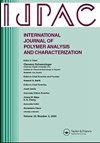增材制造仙人球填充 PETG 合成泡沫复合材料的动态力学分析
IF 1.6
4区 工程技术
Q4 POLYMER SCIENCE
International Journal of Polymer Analysis and Characterization
Pub Date : 2024-09-26
DOI:10.1080/1023666X.2024.2404906
引用次数: 0
摘要
合成泡沫复合材料(SFC)具有替代传统材料的潜力,可用于耐损伤、隔热和对重量敏感的应用领域,如汽车零件、潜艇结构等。在这里,通过改变聚对苯二甲酸乙二醇(PETG)基体中的碳圈(CS)重量分数(0-40 wt.%),开发出了 SFC。这项研究提供了三维打印 PETG/CS 泡沫复合材料粘弹性能的简明行为。热重分析(TGA)结果表明,复合丝的初始降解温度(Ti)和质量损失 50%时的温度(T50)随着 CS 粒子的加入而升高,表明热稳定性得到改善。动态力学分析(DMA)结果表明,SFC 的存储模量随纤球含量的增加而增加。泡沫复合材料的玻璃化转变温度(78.9 ± 0.35 °C)比纯 PETG 低 4 °C。这凸显了所开发的合成泡沫复合材料通过三维打印程序有效利用工业废弃粉煤灰的潜力,从而促进了可持续生产实践。本文章由计算机程序翻译,如有差异,请以英文原文为准。
Dynamic mechanical analysis of additively manufactured cenosphere-filled PETG syntactic foam composite
Syntactic foam composite (SFC) has the potential to substitute the conventional material used in damage-tolerance, thermal insulation, and weight-sensitive applications such as automotive parts, submarine structures, etc. Here, SFCs were developed by varying the weight fraction of cenosphere (CS) content from 0-40 wt. % in a polyethylene terephthalate glycol (PETG) matrix. This investigation provides the terse behavior of the viscoelastic properties of 3D-printed PETG/CS foam composites. The thermogravimetric analysis (TGA) results showed that the initial degradation temperature (Ti) and the temperature at 50% mass loss (T50) of the composite filament increased with the addition of CS particles, indicating improved thermal stability. The dynamic mechanical analysis (DMA) results revealed that the storage modulus of SFC increased with increasing cenosphere content. The foam composite’s glass transition temperature (78.9 ± 0.35 °C) is lower by 4 °C than pure PETG. This underscores the potential of the developed syntactic foam composite to effectively utilize industrial waste fly ash through 3D printing routine, thereby promoting sustainable manufacturing practices.
求助全文
通过发布文献求助,成功后即可免费获取论文全文。
去求助
来源期刊
CiteScore
3.50
自引率
5.30%
发文量
37
审稿时长
1.6 months
期刊介绍:
The scope of the journal is to publish original contributions and reviews on studies, methodologies, instrumentation, and applications involving the analysis and characterization of polymers and polymeric-based materials, including synthetic polymers, blends, composites, fibers, coatings, supramolecular structures, polysaccharides, and biopolymers. The Journal will accept papers and review articles on the following topics and research areas involving fundamental and applied studies of polymer analysis and characterization:
Characterization and analysis of new and existing polymers and polymeric-based materials.
Design and evaluation of analytical instrumentation and physical testing equipment.
Determination of molecular weight, size, conformation, branching, cross-linking, chemical structure, and sequence distribution.
Using separation, spectroscopic, and scattering techniques.
Surface characterization of polymeric materials.
Measurement of solution and bulk properties and behavior of polymers.
Studies involving structure-property-processing relationships, and polymer aging.
Analysis of oligomeric materials.
Analysis of polymer additives and decomposition products.

 求助内容:
求助内容: 应助结果提醒方式:
应助结果提醒方式:


